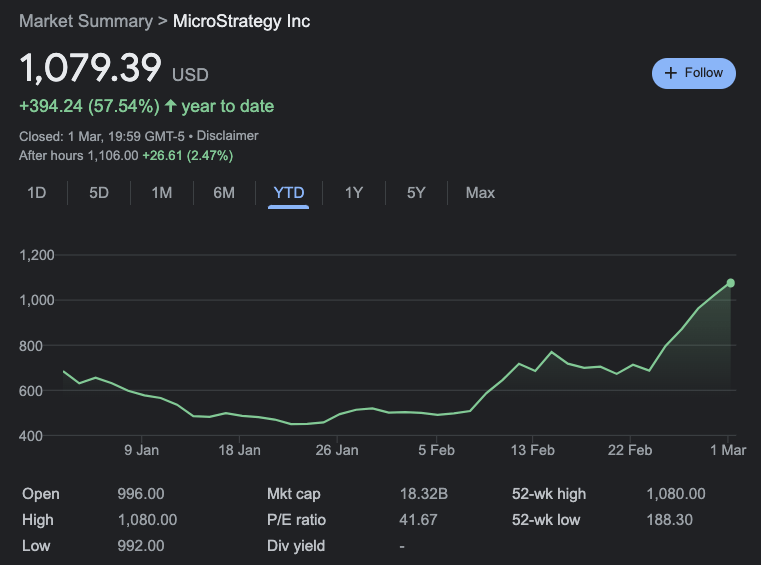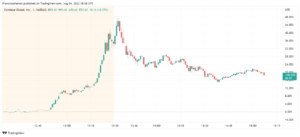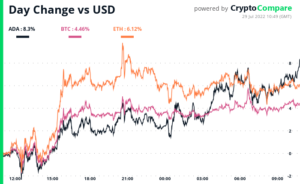Bill Miller IV has worked alongside his father at Miller Value Partners, an investment firm founded by Bill Miller. Miller Value Partners is known for its value investing approach, focusing on undervalued stocks with the potential for significant growth. The firm manages a variety of funds and investment strategies, aiming to achieve long-term capital appreciation for its clients. Their investment philosophy is grounded in detailed fundamental analysis, seeking to invest in companies that they believe are trading below their intrinsic value and have strong potential for recovery and growth.
On March 1, Bill Miller IV, Chairman and CIO of Miller Value Partners, appeared on CNBC’s “Closing Bell” to share his insights on MicroStrategy Inc. (NASDAQ: MSTR) and Bitcoin in general. Miller, known for his bullish stance on Bitcoin and related investments, reaffirmed his optimism about MicroStrategy, describing it as the firm’s largest holding and expressing belief in its substantial future growth potential. He attributed this optimism to what he views as the early stages of a significant capital repricing event, shifting towards digital assets.

Miller highlighted the distinction between Bitcoin’s market capitalization versus its realized capitalization.
Market capitalization for Bitcoin, or any cryptocurrency, is calculated by multiplying the current price of Bitcoin by the total number of coins in circulation. This metric gives a snapshot of the total value of the Bitcoin market at the current price. It’s a straightforward calculation that provides a quick way to compare the size and value of Bitcoin to other cryptocurrencies or assets. However, market cap can be volatile, fluctuating with the rapid changes in Bitcoin’s price.
Realized capitalization offers a more nuanced view of Bitcoin’s value. Instead of using the current price for all Bitcoins, realized cap calculates the value of each Bitcoin at the price it was last moved or traded. Essentially, it aggregates the value of all Bitcoins at their individual transaction prices. This metric can provide a deeper understanding of the market’s behavior over time, reflecting how much money has actually been invested in Bitcoin, rather than its hypothetical market value.
Realized cap is significant for several reasons:
- Long-term Investment Insight: It can highlight the behavior of long-term holders by showing the price at which they purchased Bitcoin. If the realized cap is significantly lower than the market cap, it might indicate that many investors bought in at lower prices and could be sitting on substantial unrealized gains.
- Market Stability Indicator: A high or rising realized cap suggests that Bitcoin is being bought and held by investors, rather than being rapidly traded. This could be seen as a sign of stability and long-term confidence in Bitcoin.
- Investor Profitability: This can influence future market sentiment and investor behavior.
Highlighting the significance of realized cap, Miller noted that it currently stands at $24,000, indicating that the average Bitcoin holder has realized a 150% return on their investment. This metric underlines the substantial amount of fiat currency—$500 billion—that has been converted into Bitcoin. It underscores the depth of Bitcoin’s acceptance and integration into the financial portfolios of investors, suggesting a robust foundation of confidence and profitability among the cryptocurrency’s holders.
Furthermore, Miller’s analysis pointed to the vast potential for future growth. With hundreds of trillions of dollars of capital existing worldwide, the current $500 billion converted into Bitcoin seems just the beginning, especially considering the upcoming halving event that is anticipated to further influence Bitcoin’s value positively. The halving, a scheduled reduction in the reward for mining new blocks, traditionally tightens supply and has historically preceded significant price increases.
<!–
–>
<!–
–>
Miller also discussed the advantage Microstrategy gains from this digital capital shift. He says that beyond its business innovations, Microstrategy employs a sophisticated capital allocation strategy that leverages the arbitrage opportunities between Bitcoin and its shares, creating additional value for long-term shareholders. This strategic approach to enhancing Bitcoin per share for its holders exemplifies the kind of financial ingenuity that Miller believes will drive Microstrategy’s—and Bitcoin’s—growth forward.
The discussion also touched on the broader implications and potential of Bitcoin and blockchain technology. While Miller acknowledged the current primary use case of converting fiat to a digital ledger as significant, he also pointed to the future development of additional applications beyond this fundamental utility. Despite these potential developments, he stressed the importance of Bitcoin as a valuable asset for portfolios simply based on its appreciation potential.
Finally, Miller addressed the broader equity market, suggesting that despite the significant attention and investment flowing into digital assets like Bitcoin, there remain opportunities in well-valued stocks and companies.
[embedded content]
On February 20, Michael Saylor, the Executive Chairman and co-founder of MicroStrategy, Inc. (NASDAQ: MSTR), spoke with Katie Greifeld on Bloomberg Television, sharing his perspective on the influence of US-listed spot Bitcoin ETFs on the crypto market and MicroStrategy’s approach to Bitcoin investment.
Saylor highlighted the critical impact of the SEC’s approval of spot Bitcoin ETFs within the crypto space, viewing it as a pivotal moment that benefits the entire market by facilitating institutional investment into Bitcoin. He noted the demand for these ETFs significantly outstrips the supply from Bitcoin mining, indicating a strong institutional interest that could exceed miner output by up to ten times.
Regarding MicroStrategy’s strategy, Saylor remains unfazed by the potential competition for Bitcoin, instead welcoming the entry of institutional money as a positive force that enriches the Bitcoin ecosystem. He explained how MicroStrategy leverages this trend, positioning itself to capitalize on the shift from traditional financial systems to a digital economy.
Saylor also spoke to Bitcoin’s evolution into a trillion-dollar asset class, likening its impact to that of leading tech giants but with the unique advantage of being an expansive asset class capable of drawing substantial capital. He predicts a shift of investments from traditional assets like gold and real estate to Bitcoin, citing its technological advantages and potential as a premier store of value.
Reaffirming his long-term vision, Saylor addressed MicroStrategy’s stance on Bitcoin, emphasizing a commitment to invest in Bitcoin for the long haul. He reiterated his intention to “buy the top forever,” viewing Bitcoin not just as an investment but as the ultimate strategy, confident in its future growth and its superiority over traditional investment options.
[embedded content]
Featured Image via Unsplash
- SEO Powered Content & PR Distribution. Get Amplified Today.
- PlatoData.Network Vertical Generative Ai. Empower Yourself. Access Here.
- PlatoAiStream. Web3 Intelligence. Knowledge Amplified. Access Here.
- PlatoESG. Carbon, CleanTech, Energy, Environment, Solar, Waste Management. Access Here.
- PlatoHealth. Biotech and Clinical Trials Intelligence. Access Here.
- Source: https://www.cryptoglobe.com/latest/2024/03/miller-value-partners-cio-explains-why-he-is-so-bullish-on-bitcoin-and-microstrategy-nasdaq-mstr/
- :has
- :is
- :not
- $UP
- 000
- 08
- 1
- 20
- 360
- a
- About
- acceptance
- Achieve
- acknowledged
- actually
- Additional
- addressed
- Ads
- ADvantage
- advantages
- aggregates
- ahead
- Aiming
- All
- allocation
- alongside
- also
- among
- amount
- an
- analysis
- and
- Anticipated
- any
- appeared
- applications
- appreciation
- approach
- approval
- arbitrage
- arbitrage opportunities
- ARE
- AS
- asset
- asset class
- Assets
- At
- attention
- average
- based
- BE
- been
- Beginning
- behavior
- being
- belief
- believe
- believes
- below
- benefits
- between
- Beyond
- Bill
- Bill Miller
- Billion
- Bitcoin
- Bitcoin investment
- Bitcoin market
- Bitcoin mining
- Bitcoins
- blockchain
- blockchain technology
- Blocks
- Bloomberg
- bought
- broader
- Bullish
- business
- but
- by
- calculated
- calculates
- calculation
- CAN
- cap
- capable
- capital
- capitalization
- capitalize
- case
- chairman
- Changes
- CIO
- Circulation
- citing
- class
- clients
- Co-founder
- Coins
- commitment
- Companies
- compare
- competition
- confidence
- confident
- considering
- content
- converted
- converting
- could
- Creating
- critical
- crypto
- Crypto Market
- crypto space
- cryptocurrencies
- cryptocurrency
- CryptoGlobe
- Current
- Currently
- deeper
- Demand
- depth
- describing
- Despite
- detailed
- Development
- developments
- digital
- Digital Assets
- Digital Capital
- Digital economy
- digital ledger
- discussed
- discussion
- distinction
- dollars
- drawing
- drive
- each
- Early
- economy
- ecosystem
- embedded
- emphasizing
- employs
- enhancing
- Entire
- entry
- equity
- especially
- essentially
- estate
- ETFs
- Event
- evolution
- exceed
- executive
- exemplifies
- existing
- expansive
- explained
- Exploring
- expressing
- facilitating
- February
- Fiat
- financial
- financial systems
- Firm
- Flowing
- focusing
- For
- Force
- forever
- Forward
- Foundation
- Founded
- from
- fundamental
- funds
- further
- future
- future growth
- Gains
- gateway
- General
- giants
- gives
- Gold
- grounded
- Growth
- growth potential
- Halving
- Have
- he
- Held
- High
- Highlight
- Highlighted
- his
- historically
- holder
- holders
- holding
- How
- However
- HTTPS
- Hundreds
- if
- image
- Impact
- implications
- importance
- in
- Inc.
- Increases
- indicate
- indicating
- Indicator
- individual
- influence
- ingenuity
- innovations
- insight
- insights
- instead
- Institutional
- Institutional Interest
- institutional investment
- integration
- Intention
- interest
- into
- intrinsic
- Invest
- invested
- investing
- investment
- Investments
- investor
- Investors
- IT
- ITS
- itself
- just
- Kind
- known
- largest
- Last
- leading
- Ledger
- leverages
- like
- Long
- long-term
- long-term holders
- lower
- manages
- many
- March
- March 1
- Market
- Market Cap
- Market Capitalization
- market sentiment
- market value
- massive
- max-width
- metric
- Michael
- Michael Saylor
- MicroStrategy
- Microstrategy Inc
- might
- Miller
- miner
- Mining
- moment
- money
- more
- moved
- MSTR
- much
- multiplying
- Nasdaq
- New
- noted
- nuanced
- number
- of
- Offers
- on
- opened
- opportunities
- Optimism
- Options
- or
- Other
- output
- outstrips
- over
- partners
- per
- perspective
- philosophy
- pivotal
- plato
- Plato Data Intelligence
- PlatoData
- portfolio
- portfolios
- positioning
- positive
- positively
- potential
- Predicts
- premier
- price
- Prices
- primary
- profitability
- provide
- provides
- purchased
- Quick
- rapid
- rapidly
- rather
- reaffirmed
- real
- real estate
- realized
- reasons
- recovery
- reduction
- reflecting
- related
- remain
- remains
- return
- Reward
- rising
- robust
- runway
- Saylor
- says
- scheduled
- Screen
- screens
- seeking
- seems
- seen
- sentiment
- several
- Share
- Shareholders
- Shares
- sharing
- shift
- SHIFTING
- showing
- sign
- significance
- significant
- significantly
- simply
- Sitting
- Size
- sizes
- Snapshot
- sophisticated
- Space
- Spot
- Stability
- stages
- stance
- stands
- Still
- Stocks
- store
- store of value
- straightforward
- Strategic
- strategic approach
- strategies
- Strategy
- strong
- substantial
- Suggests
- superiority
- supply
- Systems
- tech
- tech giants
- technological
- Technology
- television
- ten
- than
- that
- The
- The Future
- their
- There.
- These
- they
- this
- tightens
- time
- times
- to
- top
- Tops
- Total
- touched
- towards
- traded
- Trading
- traditional
- traditionally
- transaction
- Trend
- trillions
- ultimate
- underlines
- underscores
- understanding
- unFaZed
- unique
- upcoming
- use
- use case
- using
- utility
- Valuable
- value
- value of bitcoin
- variety
- Vast
- Versus
- via
- View
- viewing
- views
- vision
- volatile
- was
- Way..
- welcoming
- What
- which
- while
- why
- will
- with
- within
- worked
- worldwide
- youtube
- zephyrnet











